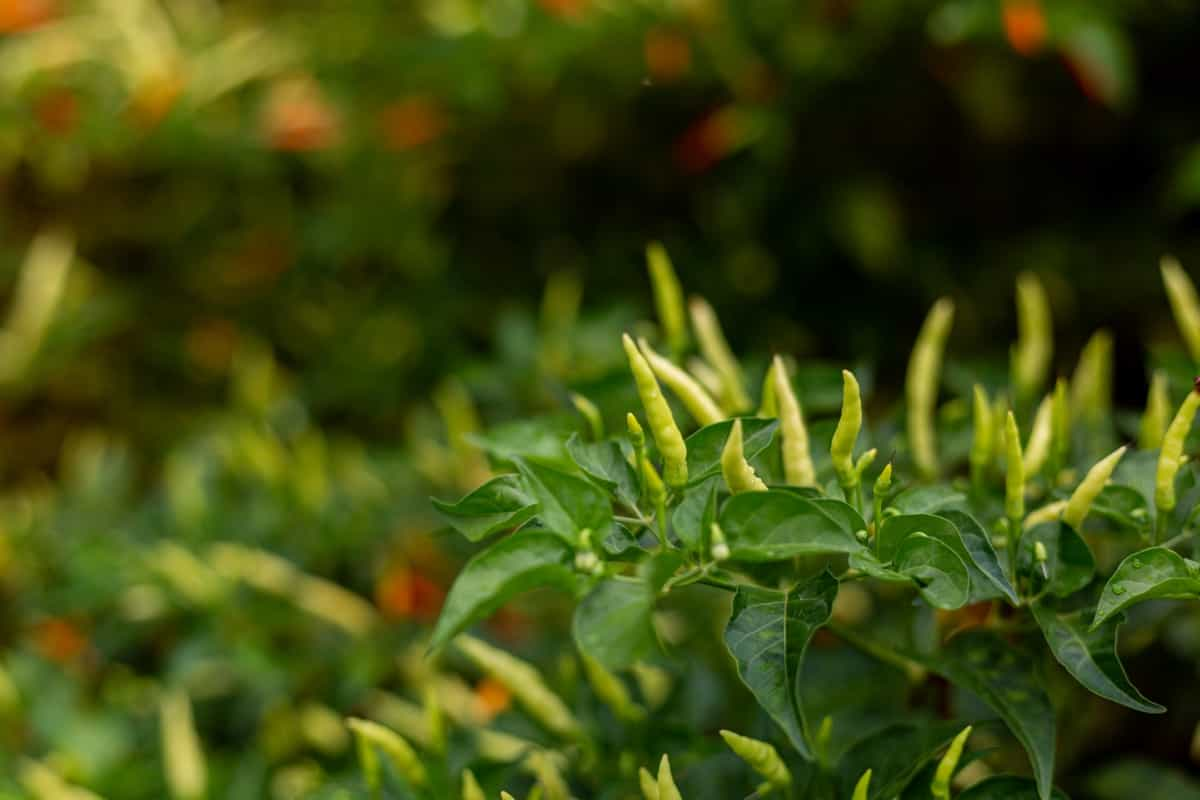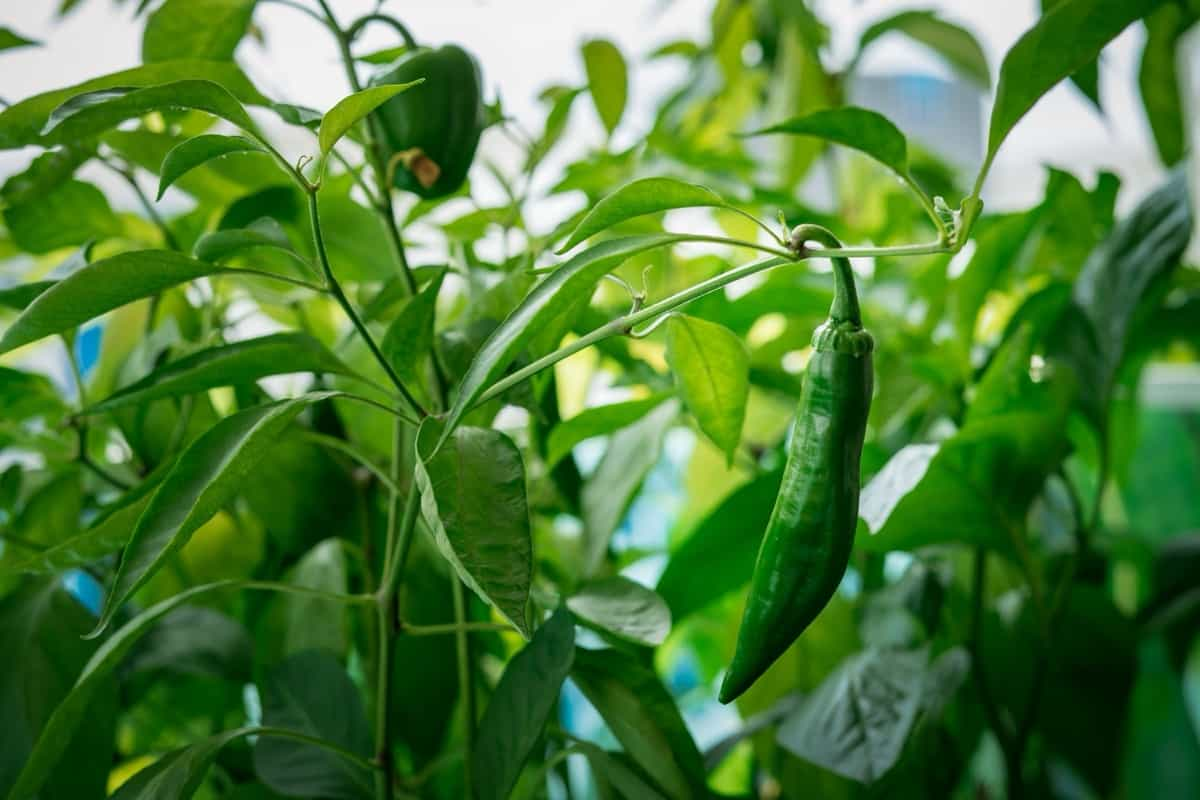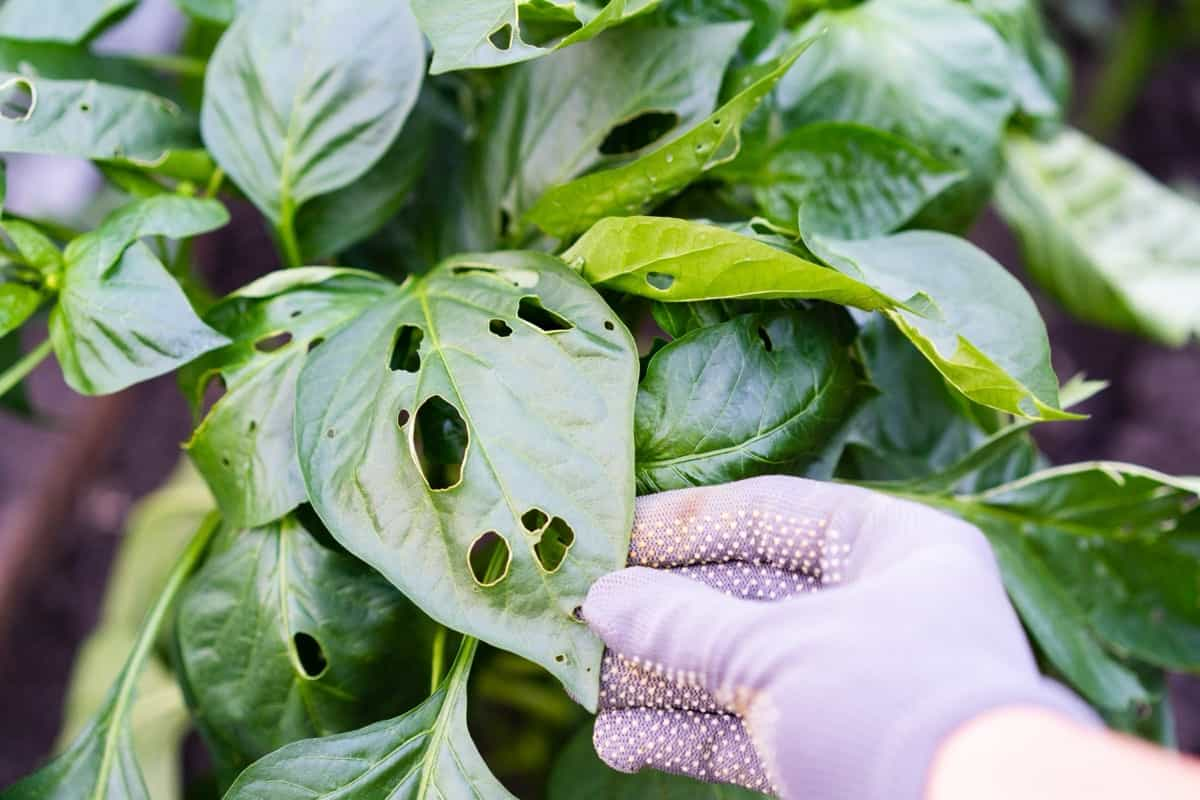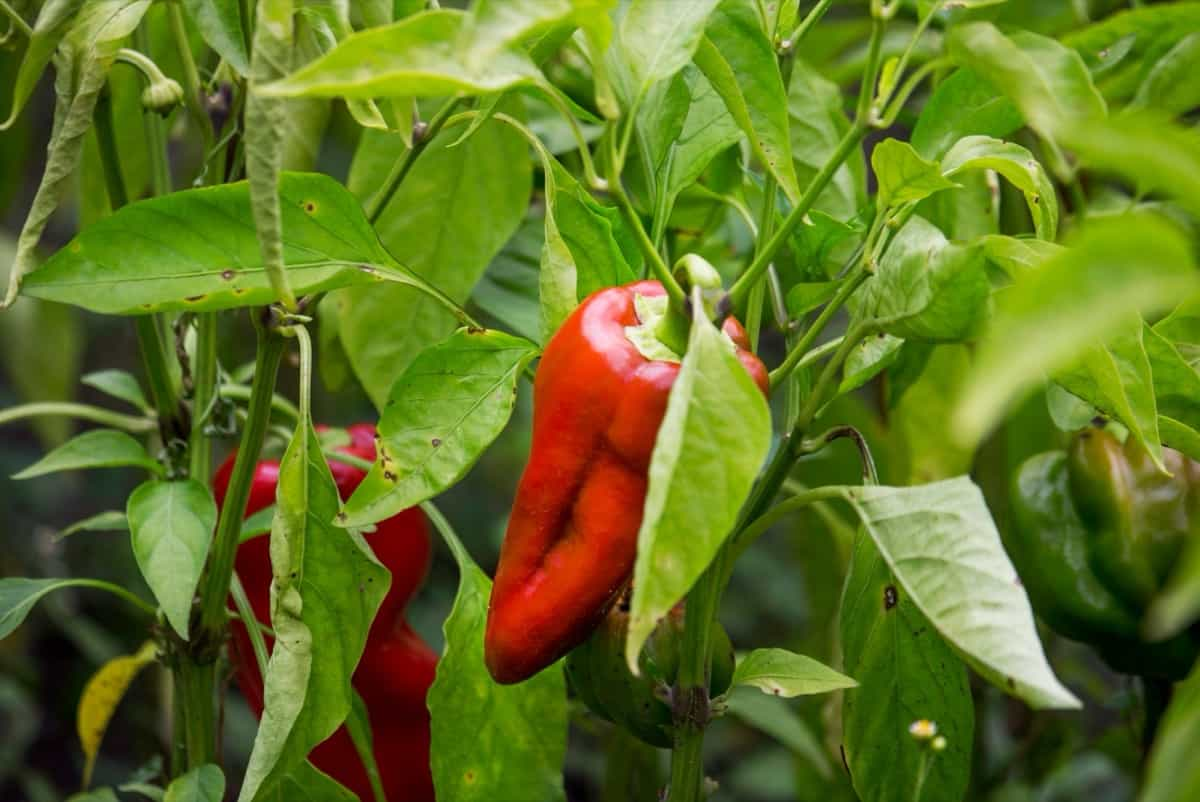Taking care of your chili pepper plants and protecting them from pests is essential for a successful harvest. While chemical insecticides may seem like an easy solution, they often harm the environment and can contaminate your fruits and vegetables. Incorporating natural pest control methods, such as homemade insecticides, into your gardening routine is safe and effective. Using ingredients in your kitchen or garden can create DIY insecticides to combat common pests that affect chili plants.

Homemade Insecticide for Chilli Plants
Neem Oil Recipe#1: A Natural and Effective Insecticide for Chilli Plants
Neem oil has long been a natural and effective insecticide for various plants, including Chilli peppers. Made from the seeds of the neem tree, this oil is known for its powerful pesticidal properties. To create your neem oil insecticide for Chilli plants, mix two to three tablespoons of neem oil with 1 gallon of water. Make sure to use pure, cold-pressed neem oil for maximum effectiveness.
Next, add ½ teaspoon of liquid dish soap to the mixture. This will help the solution stick to the leaves and pests more effectively. Once everything is combined, generously apply it to both sides of the leaves on your chili plants. Be thorough in your application to ensure all areas are covered. The active compounds in neem oil disrupt insects’ hormonal systems and prevent them from feeding and reproducing. This makes it an excellent choice for controlling common pests like aphids, whiteflies, and spider mites that can damage Chilli plants.
Soap Solution Recipe#2: A Simple and Non-Toxic Insecticide for Chilli Plants
If you’re looking for a natural and non-toxic way to keep pests away from Chilli plants, look no further than soap solution. This DIY insecticide is easy to make and highly effective in controlling common garden pests. The soap acts as a surfactant, which helps the solution stick to the insects’ bodies, suffocating them.
Mix a teaspoon of liquid dish soap with one liter of water to make your soap solution. Stir gently until well combined. Be sure to use mild or organic dish soap without harsh chemicals that could harm your plants. Once your mixture is ready apply directly onto the affected areas of your Chilli plants. Make sure to cover both sides of the leaves thoroughly for maximum effectiveness.
Garlic Spray Recipe#3: A Natural Insect Repellent for Chilli Plants
Using garlic spray as a natural insect repellent, you can keep those unwanted visitors at bay and protect your Chillies. Crush several fresh garlic cloves to make this simple yet effective homemade insecticide. This will release the potent compounds that repel insects. Then, mix the crushed garlic with water and let it steep for several hours or overnight.
In case you missed it: How to Control Pests and Diseases in Chilli Crop: Causes, Symptoms, Chemical, and Biological Management

Once the mixture has been infused, strain out the garlic solids and transfer the liquid into a spray bottle. Now, you’re ready to give your Chilli plants some extra protection. Simply spray the solution onto both sides of the leaves of your plants, making sure to cover them thoroughly. The strong scent of garlic will act as a barrier against pests like aphids, spider mites, and whiteflies. It’s important to note that this repellent may need reapplication after rain or heavy watering.
Cayenne Pepper Spray Recipe#4: A Hot and Effective Insecticide for Chilli Plants
The natural compound in cayenne pepper called capsaicin irritates insects, causing them to stay away from your precious Chillies. Mix one or two tablespoons of cayenne pepper powder with one quart of water to make a simple cayenne pepper spray. Add 2 to 3 drops of dish soap to help the mixture adhere to the leaves. Shake well and then strain the mixture into a spray bottle.
Wear gloves when using this hot concoction on your Chilli plants, and avoid getting it in your eyes or mouth. Spray the solution liberally over the leaves of your plants, making sure to cover all areas where pests may hide. The strong smell and taste of cayenne pepper will deter many common garden pests, such as aphids, spider mites, and caterpillars. Reapply every week or after rain showers for maximum effectiveness.
Pyrethrin Spray Recipe#5: A Natural Insecticide for Chilli Plants
If you’re looking for a natural and effective insecticide to protect Chilli plants, look no further than pyrethrin spray. To make your pyrethrin spray at home, start by crushing dried chrysanthemum flowers into a fine powder. You can also purchase pyrethrins in powder form from gardening stores.
Mix one tablespoon of the powdered pyrethrins with one gallon of water and shake well. Once mixed, transfer the solution into a spray bottle or garden sprayer. When applying the pyrethrin spray to your Chilli plants, focus on targeting areas where pests are present or prone to attack. It’s always best to follow label instructions carefully and avoid spraying directly onto edible parts of your Chilli plants.
Diatomaceous Earth Recipe#6: A Natural Insecticide for Chilli Plants
To use diatomaceous earth as an insecticide for your chili plants, simply sprinkle it around the base of each plant and on the leaves. As soon as the bugs come into contact with this powdery substance, it will effectively damage their exoskeletons and dehydrate them, leading to their ultimate demise. Wear gloves when applying it, and avoid inhaling large dust particles. One important thing to remember about diatomaceous earth is that it works best when dry. So, if you expect rain or watering your plants soon after application, you may need to reapply the powder.
Bacillus Thuringiensis Recipe#7: A Bacterial Insecticide for Chilli Plants
Purchase a product containing live bacteria to make your own Bacillus Thuringiensis spray. Follow the instructions to mix it with water in the recommended ratio. Then, use a sprayer to apply the solution evenly onto your Chilli plants. The beauty of using Bacillus Thuringiensis is that it only affects certain types of insects, such as caterpillars and worms. Once ingested by these pests, Bacillus Thuringiensis releases toxins that paralyze their digestive systems and ultimately lead to their death.
In case you missed it: Growing Peppers from Seed to Harvest: For Bell Peppers, Chilli Peppers, Spicy/Hot Peppers, Sweet Peppers, and Jalapeno Peppers

Horticultural Oil Recipe#8: A Refined Insecticide for Chilli Plants
Horticultural oil is a refined insecticide that can control pests on Chilli plants. It is made from petroleum or vegetable oils and suffocates insects by coating their bodies and blocking their breathing pores. This natural solution is effective against many pests, including aphids and scale insects.
To make your horticultural oil spray for Chilli plants, you’ll need two tablespoons of horticultural oil and 1 gallon of water. Mix the ingredients thoroughly and apply the solution to the leaves and stems of your Chilli plants. One great thing about horticultural oil is its minimal impact on beneficial insects such as ladybugs and bees. Unlike chemical pesticides, this natural insecticide does not harm these helpful creatures while targeting pests.
Insecticidal Soap Recipe#9: A Gentle Insecticide for Chilli Plants
Mix one to two tablespoons of liquid dish soap with one quart of water. Stir it well until the soap is completely dissolved. When applying the insecticidal soap to your Chilli plants, thoroughly cover both sides of the leaves. This will help smother any existing insects and deter new ones from settling in. Remember that this recipe works best on soft-bodied insects like aphids or spider mites.
Beer Traps: A Natural Insecticide for Chilli Plants
These traps attract slugs, snails, and other garden pests with the smell of beer. Once they crawl into the trap, they drown in the liquid. To make a beer trap for your Chilli plants, simply bury a shallow container in the soil near your plants and fill it halfway with beer. The pests will be drawn to the sweet scent of the drink and fall into their doom. One important thing to note is that you should use cheap beer for this purpose, as expensive craft beers may not have the same effect on insects.
Companion Planting: A Natural Insect Repellent for Chilli Plants
Companion planting is an effective way to repel insects from your chili plants. By strategically planting certain companion plants near your chilies, you can create an environment that deters pests and promotes healthy growth. One popular companion plant for chili peppers is Marigold. The strong scent of marigolds acts as a natural insect repellent, keeping aphids, nematodes, and other harmful bugs away from your chili plants.
Plus, the bright flowers add a pop of color to your garden. Another great companion plant for chilies is Basil. It enhances the flavor of your dishes when paired with fresh chili peppers, and Basil also helps repel mosquitoes and flies. It’s a win-win situation. Additionally, planting Onions or Garlic near your chili plants can help deter pests like aphids and caterpillars.
In case you missed it: Homemade Insecticide for Roses: Homemade Remedies for Natural Pest Control on Rose Plants

These pungent bulbs emit sulfurous compounds that keep unwanted insects at bay. You can also try interplanting beans with your chilies. Beans enrich the soil around them with nitrogen-fixing properties, providing essential nutrients for healthy chili plant growth while naturally deterring pests.
Row Covers: A Physical Barrier for Chilli Plants
Row covers are a fantastic tool in the battle against pests for your chili plants. These physical barriers create a protective shield that keeps insects and other unwanted visitors at bay. Made from lightweight fabric, row covers can be easily draped over your plants, creating an impenetrable barrier while allowing sunlight and water to reach your precious peppers. The beauty of row covers lies in their simplicity. Simply drape them over your plants and secure them with stakes or rocks at the edges to prevent any sneaky bugs from finding their way in.
One of the key advantages of using row covers is that they are completely chemical-free. This means you can protect your chili plants without using harsh insecticides or pesticides that may harm beneficial insects or contaminate your produce. Another benefit of row covers is that they are reusable season after season. With proper care and storage, these handy barriers can last for years, saving you money in the long run.
Sticky Traps: A Non-Toxic Insecticide for Chilli Plants
Sticky traps are a fantastic, non-toxic option for controlling insects on Chilli plants. These simple yet effective devices attract and trap insects with a sticky surface. The concept is straightforward, but the results can be astonishing. Placing sticky traps around your Chilli plants creates a physical barrier that prevents pests. The trap’s adhesive surface catches flying insects like aphids, whiteflies, fungus gnats, and crawling pests like thrips and spider mites.
In case you missed it: Unleash Your Green Thumb: Top Expert Tips for Growing the Tastiest Bell Peppers

Using sticky traps is incredibly easy. Simply hang them near your Chilli plants or into the soil to keep them at ground level. Regularly check the traps and replace them when they become full of captured insects. One advantage of using sticky traps is that they do not involve chemicals or toxins harmful to humans or pets.
They provide an environmentally friendly alternative for pest control in your garden while safeguarding the health of beneficial insects like ladybugs and bees. Remember to strategically place these yellow or blue sticky traps throughout your Chilli plant area to maximize their effectiveness against various pests. With consistent use, you’ll notice a significant reduction in insect populations without resorting to harsh chemicals.
Frequently Asked Questions about Homemade Insecticide for Chilli Plants
Are Homemade Insecticides as Effective as Commercial Products?
Homemade solutions can effectively control pests if used correctly and consistently. However, keep in mind that their effectiveness may vary depending on pest type and infestation severity.
How Often Should I Apply Homemade Insecticide to My Chilli Plants?
The frequency of application is based on various factors like pest pressure and weather conditions. Generally, it’s recommended to spray once a week or after heavy rainfall. Monitor your plants regularly and adjust the frequency accordingly. Always test any new recipe or product on a small portion of your plant before applying it extensively.
Do Homemade Insecticides Harm Beneficial Insects?
Most homemade insecticides specifically target harmful pests while being safe for beneficial insects. However, it’s always a good idea to carefully read the instructions and test any new spray on a small area of your plant before applying it more widely.
In case you missed it: How to Grow Anaheim Peppers from Seed: The Complete Planting to Harvest Guide

Conclusion
These DIY remedies let you keep your plants healthy without relying on harmful chemicals. Always test any homemade insecticide on a small portion of your plant before applying it fully. By incorporating these natural pest control techniques into your gardening routine, you can enjoy healthy and thriving Chilli plants while minimizing the negative impact on the ecosystem.
- Flower Garden Designs and Layouts for Beginners
- Planting and Spacing Techniques in Papaya: A Beginner’s Guide
- Growing Gold: Essential Techniques for Planting Pineapples
- How to Make Kalanchoe Plant Bushy: Home Remedies and Solutions
- 11 Reasons Why Your Gardenia is Not Blooming: Home Remedies and Solutions
- Eco Elegance: The Guide to Designing a Drought-Tolerant Landscape
- Gardening on a Slope: Strategies for Hillside Landscaping
- Nourish and Flourish: Top Organic Mulches for Thriving House Plants
- Everything You Want to Know about Indian Mogra Flower: Discover Uses and Growing
- Green Thumb Success: Expert Tips for Cultivating Greenhouse Pumpkins All Year Round
- Maximize Growth & Flavor: The Ultimate Guide to Companion Planting in Herb Gardens
- How to Control Rhododendron Problems Naturally: Home Remedies and Organic Ways to Fix Them
- Natural Magic: The Remarkable Benefits of Cinnamon for Plants
- Best Steps to Revive Dying Tulip with Natural and Organic Treatment
- 10 Reasons Why Your Angel Trumpet is Not Blooming: Remedies and Treatment
- How to Fix Periwinkle Leaf and Flower-Related Problems: Natural Remedies and Solutions
- How to Fix Zinnias Leaf and Flower Problems: Discover Natural and Home Remedies
- Organic Steps to Induce Lemon Tree Flowers: A Comprehensive Guide
- Bloom Booster: Crafting the Perfect Homemade Bougainvillea Fertilizer
- Optimizing Growth: A Guide to Applying NPK Fertilizer for Potted Plants
- 10 Best Homemade Fertilizers for Rubber Plant: DIY Recipes and Application Method
- How to Boost Female Pumpkin Flowers: Effective Steps for More Flowers and High Yields
- Transform Your Indoor Garden: Top Benefits of Pink Salt for Houseplants
- 10 Best Homemade Fertilizers for Peacock Plants (Calathea): Easy DIY Guide
- Unlock Blooms: 9 Reasons Why Your Potted Chrysanthemum is Not Blooming
- 8 Reasons Why Your Potted Hibiscus is Not Blooming: Fix it with Simple Solutions
- Unlock Blooms: 9 Key Reasons Your Potted Frangipani Won’t Flower
- 10 Reasons Why Is My Ice Plant Not Blooming: Remedies and Treatment
- 10 Reasons Why My Potted Hydrangea Not Blooming: Treatment and Remedies
- 10 Reasons Why is My Wisteria Not Blooming: Remedies and Treatment
- 10 Reasons Why is My Goldfish Plant Not Blooming: Remedies and Treatment
- Maximize Your Space: Ultimate Guide to Balcony Gardening with Grow Bags
- 10 Reasons Why Your Iris is Not Blooming: Remedies and Treatment
- 10 Reasons Why Your Anthurium Plant is Not Blooming: Treatment and Remedies
- 10 Reasons Why Your Aquaponic Plants Are Not Flowering: Remedies and Treatment
- 10 Reasons Why Your Agapanthus is Not Flowering: Remedies and Treatment